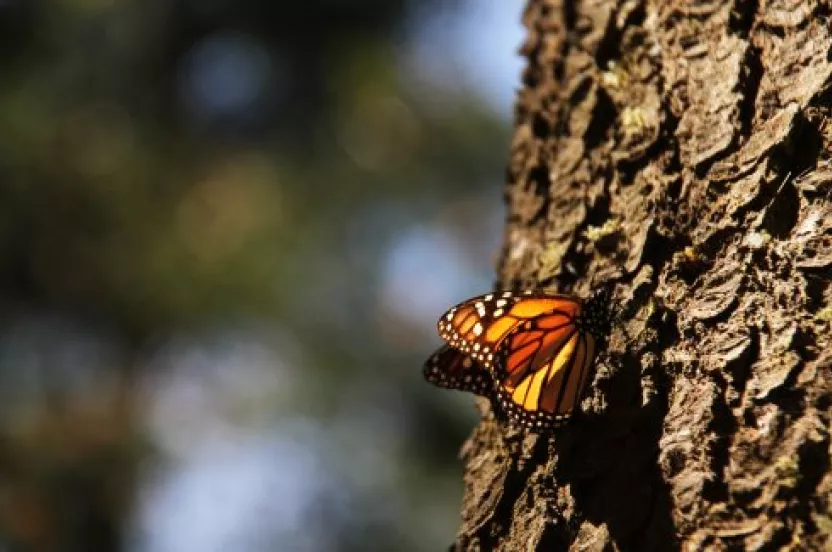Now live: The 2025 Canopy Report. Learn how Americans see trees. GET THE REPORT
You've probably heard more buzz about bees than usual lately—from unexplained deaths en masse to faltering fruit crops in their absence. One thing you've probably learned is that bees are important (if not essential) components to multitudes of ecosystems around the world: particularly ones that produce much of our food.
Why are bees so important?
When we think of bees, we typically think of their use in the production of honey and beeswax. Perhaps you've heard of the medicinal uses for bee venom—which has been used for treating arthritis, multiple sclerosis and even fibromyalgia, and more recently to treat cancer, epilepsy and depression.
While these are incredibly important functions, bees, and honeybees in particular, have a much more wide-reaching impact than many of us realize. "Typically, according to the U.S. Department of Agriculture, these under-appreciated workers pollinate 80 percent of our flowering crops which constitute 1/3 of everything we eat. Losing them could affect not only dietary staples such as apples, broccoli, strawberries, nuts, asparagus, blueberries and cucumbers, but may threaten our beef and dairy industries if alfalfa is not available for feed," says Maria Boland, of Mother Nature Network. One Cornell University study estimated that honeybees annually pollinate $14 billion worth of seeds and crops in the U.S. The University of Arizona has determined more than 100 different agricultural crops in the U.S. are pollinated by bees.
While the root causes of the problem of the great bee disappearance are still being determined (experts suggest harmful pesticides or harmful pesticide exposure, viruses and poor nutrition play large roles, in addition to ever-decreasing habitat/food sources), the issue of what proactive measures to take remains. Outside of donning a beekeeper mask/gear and cultivating hives of one's own (which is certainly an option, though it's not for everyone), what can a person do to help these productive members of our planet?
Luckily, there are many things.
- Avoid spraying plants in bloom and apply chemicals after bees have returned to their colonies at night. The best way to conserve pollinators, according to the Xerces Society, is to avoid pesticides altogether.
- Where possible, plant or maintain regionally native plant species—in general, they are able to support a larger number of species than non-native plants and often have a higher habitat or food value…especially for bees. Some native bee species are "specialists" and forage only a few specific native plants. Also, single-flowered plants (which are closer to their natural form) are better for bees than double-or triple-flowered ornamental and fruit trees.
- Provide nesting sites for our native bees in your landscape by leaving areas of your yard or garden undisturbed and uncultivated. These bees are solitary or nest in very small numbers with different nesting requirements from the large hives created by European honeybees.
- Plant a mix of trees and shrubs that are rich sources of both nectar and pollen, as bees need both for proper nutrition. (Don't have space for any more trees? Planting crocus, anise hyssop, bee balm and asters in your perennial garden can be of great service to bees, too).
- When creating the plan for or adding to your garden/yard, use a diversity of plant species with a succession of blooms from early spring through fall…this provides foraging bees with steady sources of nutrition. Clumping plants of the same species into a small area attracts more bees than individual or widely scattered plants.
Bee-friendly spring blossoms:
(Very early bloom time): Maple, Willow, Elm, Hybrid Hazelnut, Almond, and Oak
(Early to later bloom time): Crabapple , Apple, Cherry, Plum (and most other fruit trees), Hickory, Redbud, Sassafras, Tupelo, and Native Mesquite
Bee-friendly summer blossoms:
(Very early bloom time): American Mountainash, Catalpa, Viburnum, Blackberry, Blueberry, Raspberry
(Early to later bloom time): Sourwood, Baswood, Littleleaf Linden, Elderberry, Rose and Native Mesquite (second bloom period)
Bee-friendly fall/winter blossoms:
Franklin Tree, California Laurel, Potentilla, Blue Mist Shrub, Bodnant Viburnum, Seven-Son Flower, Sunflower and Aster
What are you doing to help out our pollinator friends or what would you like to do? Leave your comments below.
Want more buzz? Read Want Bees? Plant These!
Sources:
- Xerces Society for Invertebrate Conservation
- Plants With Special Value for Native Bees: species list - Lady Bird Johnson Wildflower Center: University of Texas at Austin
- Africanized Honey Bee Education Project- University of Arizona Extension
- Creating a Haven for Butterflies and Bees – Washington Post
- Gardening for Honeybees – State of Indiana Department of Natural Resources
- Helping Bees in Crisis: 7 Steps to Creating a Bee-Friendly Landscape - EcoBeneficial
- What Can A Lay Person Do? – Gooserock Farm (Honey & Beeswax Producers)
- USDA and EPA Release New Report on Honey Bee Health – Environmental Protection Agency
- Gardening to Attract Honeybees – Arbor Day Foundation Blog




